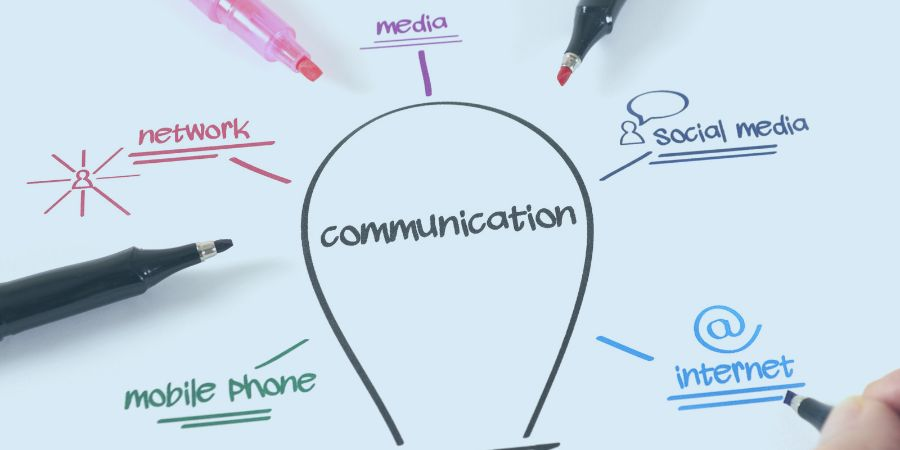The Importance of Crisis Communication During a BC Incident
Published on January 04, 2019
Last updated on June 25, 2024
Jump to a section
Building a Crisis Management Plan
Crisis communication is an integral part of crisis management. The sooner and more efficiently you communicate a crisis situation to the crisis management team and the rest of the employees, the better you can soften the potentially negative blow of such an incident. When a crisis occurs, make sure you have a solid plan to communicate the action steps to the rest of the team, especially to the internal and external stakeholders. It's also a critical part of your business continuity measures.
Read on to find out how to effectively execute crisis communication planning and why it's important for business continuity.

What is a Business Continuity (BC) Incident?
A BC incident is any event that disrupts normal business operations, especially critical business functions. These incidents can vary from a natural disaster to a power failure, or a product recalls to any activity that could negatively impact your organization's reputation. Simply put, it's any incident that presents a potential risk to your company's ability to function.
BC incidents vary in severity and duration. Some of these incidents can happen in the short-term, such as a power failure or a natural disaster. On other hand, certain incidents can last longer, such as the recent pandemic.
Due to the unpredictable nature of these events, an organization needs to be preparing ahead for them. That way, you can handle the crisis most effectively by developing the appropriate emergency response. Crisis preparedness and crisis prevention should go hand in hand when preparing for a BC incident or possible risks.
Identifying the incidents that could pose a risk to your business continuity is a critical step in crisis preparedness and crisis response. By knowing the potential incidents that your organization is most vulnerable to, you can come up with the most effective action plan in the event a crisis occurs.
What is Crisis Communication?
Today's business landscape faces a multitude of possible risks. Whether it's a public relations matter, a social media scandal, or something else, a simple incident can end up damaging your entire company and its employees.
Crisis communication is something that is embedded into your crisis management and business continuity plans. Crisis communication refers to the systems and processes you implement when a crisis happens. You must employ various crisis communication strategies, which could vary depending on the nature and severity of the incident. Effective crisis communication could potentially manage the situation and minimize the damage of these events.
Crisis communication plans also involve communicating with internal and external stakeholders during a crisis. The goal is to provide accurate and timely information to those directly impacted by the crisis. At the same time, you should be able to address their needs during times of crisis, such as with your employees. With a solid crisis communication plan, you can protect the organization's reputation and maintain the trust of the stakeholders.
Implementing effective crisis communications is integral to crisis preparedness. Organizations must form a dedicated crisis communication team when developing a crisis communication plan. You must also define each member's roles, responsibilities, and functions that will make up your crisis team. Each member should have adequate training so they are equipped to handle any crisis situation.
The crisis communication team is solely responsible for coming up with crisis communication plans and strategies. It is also the team members who will communicate directly with stakeholders, and answer their questions if they have any.
But it's not just the stakeholders you must communicate with during a crisis. It's also essential that you address your customers. You want to reassure them that your operations are ongoing despite the crisis that you're facing. You must keep them informed about the status of your business operations since it also boosts your reputation in their eyes and helps maintain that trust.
Social media is one of the best platforms to communicate how you handle a crisis event to your customers. But it's just one of many tools that you can use to provide timely and important messages.

Develop a Crisis Communication Plan
All organizations, regardless of size or industry, are susceptible to risks. That's why businesses that strive to succeed must have good crisis communications.
A crisis communication plan consists of a set of procedures and protocols that a business uses as a guide, so you know what to do during crisis situations. Most importantly, it identifies the steps you must take to communicate those plans to your employees and key stakeholders.
The crisis communication plan outlines your crisis communication team's specific roles and responsibilities. It must also identify the primary channels to use during times of crisis. And finally, it should serve as your roadmap on how to handle various crisis situations.
Here is an example of a detailed crisis communication plan flow.
1. Identify possible risks
The first step to crisis response is always identifying potential risks and vulnerabilities. Each industry and company is different. Therefore, you have to identify the specific threats to your organization to develop an effective crisis management process.
2. Build your crisis communications team
You must designate a team for crisis communications that will be responsible for communicating and implementing your crisis management strategies. The team should consist of personnel from various departments, especially from the core business areas. It will ensure business continuity, as the most critical aspects of your business will continue running.
3. Identify protocols for crisis communications
You must identify the communication channels you'll use to communicate your plans to your employees and stakeholders. It could be SMS, email, bulletin board, voice messaging, or call conferencing. It could also be a combination of these to ensure the most effective real-time communication.
It's also important to regularly review and update these protocols to ensure they are relevant and updated.
4. Establish the tone of crisis communications
When it comes to crisis communication, the tone is equally important to the message. Make sure you use professional yet empathetic language. Keep your language clear and straightforward. Refrain from using jargon and other complex terms. The goal is to make it easy for anyone within your team to understand the message. More importantly, it should be consistent with your brand and core values.
5. Create crisis communications templates
One way that you can manage an efficient crisis communication process is to create messaging templates beforehand. This will help establish consistency with your crisis communication. You can use that template for posting on social media, press releases, and other official communication.
6. Train your crisis management team
Make sure you provide adequate training and tools to your crisis management team. Everyone must be equipped to handle any crisis event. You should regularly conduct scenario planning, employee training, and simulation exercises.
7. Regularly review and update your crisis communication plan
Conduct a periodic evaluation of your crisis communication strategies. This will ensure that any loopholes in your plan will be corrected and updated accordingly. It's also important to ensure that your crisis management strategies are effective and relevant.
8. Conduct post-crisis evaluation
Once you've overcome a crisis, performing a post-crisis evaluation is important. It will allow you to assess if your crisis communication and crisis management strategies are effective. That way, you can use the insights from the recent crisis to inform future crisis communication planning.
Essential Crisis Roles and Functions Within the Company
One of the critical aspects of crisis communication plans is to assign roles and responsibilities to your crisis communications team. You must assign roles that fit into every individual's skills and experience. Assigning roles and functions is an essential part of your crisis management plan because the success of that plan relies heavily on each member's ability to perform their expected functions.

The key decision-makers are the heart and soul of your crisis communication. These include the senior executives and the department heads. They will be vital in the development of your crisis management plan and subsequent crisis communication. The leaders must coordinate with the department heads to ensure that every business unit is taken into account.
The next important role is the spokesperson. The individual must be a senior executive or someone with a leadership position. It's their responsibility to communicate to the media and handle public relations about how they're dealing with a crisis. They should be able to provide timely and accurate reports about your crisis response and recovery.
In addition to the aforementioned roles and functions, individual members should be responsible for overseeing the most important units of your business operations. For example, you should designate logistics, legal, finance, compliance, communication, risk management, and business continuity leaders. These various departments must effectively communicate with each other to ensure that they support each other and that every unit remains operational.
Things to Consider When Communicating About an Incident
No company wants to deal with a crisis. But unfortunately, it's not a matter of if but of when. You should be prepared with a solid pre-crisis preparedness plan.
When a crisis occurs, you must know the right steps to communicate that incident to the concerned departments and individuals. How you communicate your crisis response can impact your public relations and the public perception of your company.
Maintain Transparency
Transparency is a vital part of crisis communication for businesses of all sizes. You must be forthright about your situation, especially with your key stakeholders. Make sure you provide key messages without compromising confidential information. Transparent communication acknowledges your weaknesses and shortcomings and will earn the trust of your stakeholders.
Communicate Promptly
Don't wait too long before you communicate a crisis. You should provide updates as soon as they're available. Timeliness in crisis communication exhibits professionalism and a desire to find solutions.
Use the Right Communication Channels
Focus on effective and reliable communication channels for your crisis management. You might need a combination of crisis communication channels to ensure that any pertinent information is delivered to your intended audience.

Be Open to Criticism
Each crisis incident is an opportunity to learn and improve your future crisis plans. Use whatever information you get from your crisis response to improve your strategies in the future.
During a BC incident, the importance of communicating information in the most effective way with colleagues, external suppliers and third parties is vital to an organization's ability to recover and minimize damage.
Incident notification alerts can be sent to all key personnel via Business Continuity Management Software using:
- two-way SMS,
- mass email,
- voice messaging,
- a live bulletin board,
- and call conferencing.
These communication tools can be used to deliver vital information, such as confirming all employees are safe, providing clear instructions during a cyber-attack (Don't open that email!), explaining where employees can get more information and letting everyone know when the incident is over and it is safe to return to work.
The importance of being able to communicate effectively becomes even more evident during a major incident, which could affect almost every organization within range and have a knock-on effect on businesses around the world.
Dealing With Major Business Continuity Scenarios
During such disruptive major events as the Volcanic Ash Cloud, the Japan Tsunami and the Bird Flu outbreak, all manner of systems and processes can be affected, including people, transport, buildings, suppliers and even communication systems themselves.
During these incidents, there is a greater need for accurate information to be dispersed quickly as soon as it becomes available to aid the recovery process, minimize risk to life, reduce business interruption and minimize loss.
The number one concern should be to confirm all employees are safe and have them check in as safe. Information on the next steps can then be sent. These can include instructions to secure the incident, travel to a recovery site, provide updates on the status of the situation and provide notification of further instructions over the course of the live event.
With incidents like cyber attacks on the rise, the importance of effective communication is highlighted daily. Large organizations are subject to data breaches, which put confidential information, revenue and reputation at risk.
The speed at which an organization must act to secure systems and contain any breach is vital and can be aided by effective communication tools. Depending on the cyber incident, an entire network may be down, the use of emails or laptops altogether may be restricted until the incident is under control, and other communication methods may be required.
A good resilience plan relies on several methods of communication
Companies without a resilience plan in place will need to recognise that they cannot be passive about Business Continuity, and the recovery should not wait to begin after the incident has happened.
The first time an employee receives an SMS alert should not be during a live incident. They should have been involved in multiple training exercises and be aware of the importance of an incident alert message. They should also understand why following the instructions is vital to minimize the disruption and aid recovery.
The structure of your communication plan with available resources should be designed, tested and redesigned. Frequent courses/workshops should be arranged for staff training, and regular mock exercises carried out to handle emergencies and improve the performance of the staff in real situations.
Planning, testing and using tools such as an incident notification tool can empower an organization's resilience against major disruptive incidents.
The Benefits of Using a BCMS to Facilitate Communication
A BCMS provide you with a centralized platform for managing your communication efforts, enabling you to track progress, monitor response times, and identify any areas that require improvement.
With a BCMS, you can create and distribute customized communication plans, tailored to the specific needs of your organization and its employees. By leveraging the power of a BCMS, you can enhance your communication capabilities, ensure consistency across all communication channels, and ultimately increase your team's ability to respond to and recover from a crisis.
A BCMS offers a variety of features to help you handle any disruption, including an Incident notification tool.

Incident notification tool
C2's BCM Software has a fully functional Notification / Incident Management capability including:
- Two-way SMS,
- Mass Email,
- Voice Messaging,
- Bulletin Board,
- Call Conferencing.
The Incident Management system enables the team controlling the incident to call out and stay in touch during live incidents with just a few clicks.
The system allows for seamless communication with individuals, recovery teams and others in the enterprise as needed.
A live bulletin board can be used after initial alerts to provide live updates over the course of a major incident which may last hours or even days. This prevents a single source of information from being bogged down with calls and emails requesting updates.
An Incident Checklist can be set up prior to an incident within the system, and checklist items can be assigned as actions, emailed to key personnel, and the overall progress of the recovery managed through to completion.
The Bottom Line
Crisis communication plays a crucial role in overcoming a business continuity incident. Effective communication help organizations manage a crisis efficiently and minimize the negative impact on their reputation, stakeholders, and overall business operations. You should have a clear communication plan in place, including designated communication channels, roles and responsibilities to ensure timely and accurate information is delivered to all stakeholders.
Additionally, organizations should prioritize transparency, empathy, and authenticity in their communication efforts to build trust and maintain credibility with their stakeholders. By following these guidelines, businesses can weather a crisis more effectively and emerge stronger on the other side.
C2 Meridian was designed by BC professionals as a solution to the problems and gaps they identified in the traditional methods of planning and managing business continuity.
Our web-based solution allows the automation of business continuity functions, providing cost and time savings to any business. We work daily to make your jobs easier and your business more resilient.
Book a demo today to find out more about our Business Continuity Management Software and our notifications tool.
Written by Lisa McStay
Chief Operating Officer at Continuity2
As a proud COO of Continuity2, Lisa strives to provide intuitive and innovative solutions for the Business Resilience market and reshape the industry as we know it today. Lisa has been in the industry for over 10+ years, helping clients achieve their Business Continuity and Resilience objectives for continuous growth and success.


Written by Lisa McStay
Chief Operating Officer at Continuity2
As a proud COO of Continuity2, Lisa strives to provide intuitive and innovative solutions for the Business Resilience market and reshape the industry as we know it today. Lisa has been in the industry for over 10+ years, helping clients achieve their Business Continuity and Resilience objectives for continuous growth and success.